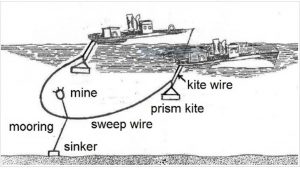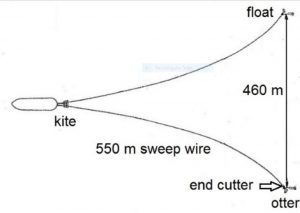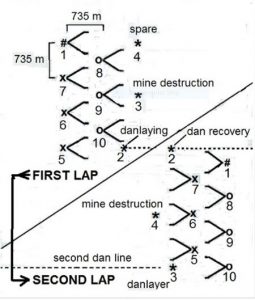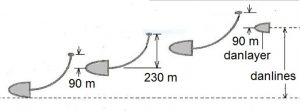- Author
- Turner, Mike
- Subjects
- History - general, Naval technology
- Tags
-
- RAN Ships
- None noted.
- Publication
- December 2019 edition of the Naval Historical Review (all rights reserved)
By Mike Turner
It is difficult to obtain accurate numbers for the total number of sea mines that have been laid, but the estimate is about 900,000, of which about 800,000 were contact moored mines. Very hazardous sweeping with team sweeps in World War I was replaced by relatively safe sweeping in World War II with single ship sweeps, known as Oropesa sweeps. They are still in service as the fastest method of clearing contact moored mines.
Contact moored mines (hereafter ‘moored mines’) are either detonated by the closure of a firing circuit switch or the creation of a firing circuit battery. Japanese mines in the Russo-Japanese War of 1904-1905 had a pendulum inertia switch which closed when a ship hit the mine case. In World War I the American contribution to the Northern Barrage between the Orkney Islands and Norway comprised 56,033 Mk 6 mines. These mines had galvanic horns and a vertical antenna above the mine. Contact by a steel hull with either a horn or the antenna created a sea cell battery. British Mk XVII mines included 426 mines made by the Ford Motor Company in Australia during World War II. Contact by a hull with one of its switch horns closed the switch. During this war Ford also made 12,561 British Mk XIV mines for laying by HMAS Bungaree. A battery was created when a Hertz horn was fractured by a hull.
During the two world wars the RAN swept 46 German, 88 Japanese and 2,675 RAN moored mines, and they all had Hertz horns. Most moored mines utilise Hertz horns, and many are still in service today. RAN Clearance Diving Team 3 encountered LUGM 145 contact moored mines during the 2003 Iraq War. This mine is a copy of the Soviet M-08 Hertz horn mine which entered service in 1908, 40 years after the Hertz horn was invented by the Prussian scientist Dr Albert Hertz.

RN wire sweeping in World War I
In the Russo-Japanese War of 1904-1905 each side laid about 1,000 moored mines. Losses were heavy, including the loss of four battleships. After experimenting with countermining, by 1910 the Royal Navy had developed wire sweeps. At the end of World War I Britain had 726 minesweepers, including 412 trawlers. An ‘A’ catenary sweep was towed by at least two minesweepers and, with the possible exception of the guide, they were in unswept water. Britain lost 214 minesweepers whilst sweeping 11,487 British and German moored mines.
The British ACETAEON sweep was the first single-ship wire sweep, and the forerunner of the double Oropesa sweep. It had six cutters on each sweep wire, but was only suitable for search sweeping. (In 1919 HMAS Protector towed an ACTAEON sweep for search sweeping near Gabo Island).
Oropesa sweeps
The development of Oropesa sweeps was by far the most significant event in wire sweeping and provided relatively safe clearance sweeping. Serrated sweep wire was introduced into the Royal Navy in 1916. This wire has one irregular strand which, when under strain, had a sawing effect on a mine mooring. Single and double Oropesa sweeps with serrated sweep wire were developed in 1916 using HM Trawler Oropesa as the trials vessel. It appears that the Oropesa sweep was used by the RN to some extent in 1918 and significantly reduced minesweeper losses. It was formally introduced into service in 1919.
RAN wire sweeping in World War I
The RAN used a two-ship ‘A’ sweep with a swept width of 370 m to clear German moored mines laid by the German raider Wolf near Gabo Island in World War I. At least one of the two minesweepers was a trawler which stowed 2740 m of 20 mm diameter sweep wire on its winch. Twelve mines were swept by the RAN minesweeping force – HMA Ships Coogee and Protector, requisitioned trawlers Brolga, Gunundaal and Koraaga and requisitioned tugs Cecil Rhodes, Champion and James Patterson.

Garden Island Dockyard made the buoyant wooden prism kites, a triangular tube 3.7 m long weighing 1 tonne. The first sweeping operation was by Gunundaal and Koraaga near Gabo Island, and the RAN swept its first mine on 9 October 1917. The minesweeping procedure was:
- Gunundaal (winch vessel) passed the end of her sweep wire to Koraaga (slip vessel).
- Gunundaal veered 960 m of sweep wire.
- Gunundaal’s sweep wire winch brake was set so that the sweep wire veered when a mine was picked up in the sweep.
- Each sweeper attached and veered its kite to commence sweeping.
- When a mine was picked up in a sweep there were two methods used to bring the mine to the surface. Either the two minesweepers proceeded to shallower water, both kites were hoisted and the mine slipped to allow it to surface, or the sinker was dragged along the sea bed until the mooring parted.
- Mines were detonated or sunk by rifle fire (The lighthouse keeper’s rifle was borrowed for this first operation).
RAN wire sweeping in World War II
In World War II the RAN was well prepared for clearing moored mines. Oropesa wire sweeps were fitted in 56 Australian Minesweepers (AMS, better known as Bathurst class corvettes), and 22 requisitioned Fairmile class Harbour Defence Motor Launches (HDMLs).
Single Oropesa was always the sweep used for clearance sweeping. It was also used by requisitioned vessels for search sweeping to detect the existence of minefields at Australian ports. Double Oropesa sweeps were used for search sweeping and escort sweeping ahead of troop ships. Double Oropesa was also used for check sweeping to verify that an area had been cleared, and 10 AMS were used in Formation K or modified Formation K. A reversal of course at the end of a lap was made with minesweepers changing station as shown in Figure 4.
An AMS had seven dan buoys for danlines (see Figures 4 and 5), two Mk 1 Oropesa floats and four Mk 1 Kite Otter Multiplanes (KOM) that could be rigged as either a kite or an otter. xx The sweep wire was 20 mm diameter serrated wire, and there was a static cutter at the otter end to prevent a mine mooring fouling the otter. Requisitioned vessels generally had the smaller Mk 2 Oropesa gear, and a few had the even smaller Mk 3 Oropesa gear.
With Formation G only the guide could normally be in unswept water. The RAN swept 2,797 moored mines for the loss of only one AMS, HMAS Warrnambool (as described in an earlier article).
Harbour Defence Motor Launch (HDML)
The RAN swept 1,609 Mk XIV defensive moored mines at the Great Barrier Reef in 1947. The risk to the guide was reduced by precursor sweeping by a 1.7 m draught HDML which had a single Mk 5 Oropesa wire sweep. Sweeping was at slow speed, and the sweep wire was not serrated. Two Mk 4 explosive cutters were attached to the sweep wire near the otter, an explosive charge propelling a chisel against a mooring. A HDML laid the initial dan buoys and then swept a 110 m wide path for the guide’s first lap in Formation G. HDMLs were also used effectively for post war clearance sweeping in the islands and the Great Barrier Reef in waters unsuitable for AMS.


Helicopter wire sweep
The wire sweep for helicopters is the Mk 103 Double Oropesa sweep which entered service with the USN in 1967. This sweep differs from earlier double Oropesa sweeps in that the forward ends of the two sweep wires terminate at the kite instead of the minesweeper (as for the ACTAEON sweep described earlier) and there are monoplane depressors and otters. The Australian Maritime College in Launceston used these features in their design of the Double Oropesa sweep in the Huon class minehunters.
Unconventional wire sweeping
There was some ‘two horsepower’ sweeping at Belgium and Turkey after World War I. Flemish dray horses towed sweeps in the canal between Zeebrugge and Bruges in Belgium. Captain T Dorling DSO, RN (‘TAFFRAIL’) reported that:
One on each bank they towed the sweep-wire between them, a party of sailors being on hand to dismantle any mines discovered. True to type, the seamen rigged the horses up as ships – one animal at least being provided with an ensign and staff at its tail; a jack and staff at its head; a mast amidships complete with yard, signal halliards and wireless aerial; an anchor and cable slung under its neck, and the sailor himself astride its back!
The Japanese made good use of defensive minefields in World War II, for example 55,347 mines were laid in Japanese home waters. However, in January 1945 the American invasion force in the Lingayen Gulf only swept three mines. This was due to 350 mines having been cleared by a Filipino guerrilla force led by a US Army officer, LTCOL Russel Volkmann. Two sailing bancas trawled for mines with a manila rope ‘A’ sweep, and a diver disconnected a located mine case from its mooring.
Mine destruction
Mine destruction was the sinking or detonation of a mine by armour piercing bullets using either a 12.7 mm Boys anti-tank rifle or a 7.7 mm (.303) rifle.
HDMLs were often used for mine destruction, generally by a 7.7 mm rifle, and they must have had some very busy days. During Operation KILHOME at the Great Barrier Reef there were no less than 43, 32 and 40 mines swept on 6, 7 and 8 March 1947 respectively.
The minimum range for mine destruction was 180 m. One group of USN ships in World War II was extremely cautious and used a range of 450 m. No less than 10,000 rounds were expended trying to sink 32 mines.
Aerial mine spotting of moored mines
The British used seaplanes in World War I for spotting in the clear waters of the Mediterranean. Some post war mines in the Dardanelles were in clear waters too shallow for wire sweeping. A British light-draught minesweeper towed a kite balloon at a height of 107 m with two RAF personnel in its gondola, one for spotting submerged mines and the other for communications via a telephone cable.

When a mine was spotted the communicator vectored the minesweeper, and she approached to within about 1 m of the mine. Three Able Seamen at the forepeak lassoed the mine with a large wire loop. The vessel went astern dragging the mine into slightly shallower water. When the towing wire was slackened the mine rose to the surface and was sunk by rifle fire.
HDMLs were used for spotting Mk XIV mines at the Great Barrier Reef. The mines were shallow, for example only 2.3 m below MLWS, and looked to be extremely close in clear waters.
The Americans used helicopters and Catalina flying boats in the Korean War. They are now replacing the Mk 1 eyeball with the AN/AES-1 Airborne Laser Mine Detection System in a MH-60S Sea Hawk helicopter.
Bibliography
BR 1736 (50) (5), War with Japan, Vol 5, The blockade of Japan, Admiralty, 1957, as CB 3303(5).
Coote, I.S., Modelling of Sweep Shape and Mine Interaction for a Lightweight Oropesa Sweep, DSTO-TR-1320, 2002. (for Huon class sweep)
Cowie, J.S., Mines, Minelayers and Minelaying, Oxford University Press, London, 1949.
Hartmann, G.K., and S.C. Truver, Weapons that Wait, Naval Institute Press, Annapolis, updated edition 1991.
Lott, A.S., Most Dangerous Sea, Bracken Books, New York, 1959.
Pollitt, G.W., email 9 May 2019. (Mk 103 sweep).
TAFFRAIL, Swept Channels – being an account of the work of the minesweepers in the Great War, Hodder and Stoughton, London, 1935.
Turner, M. and H. Donohue, Australian Minesweepers at War, Sea Power Centre-Australia, Canberra, 2017.




